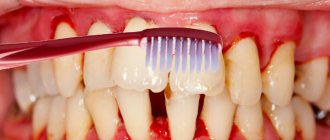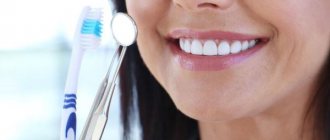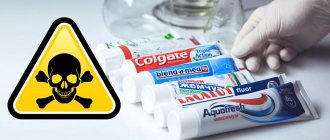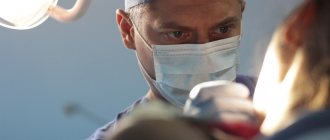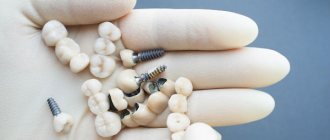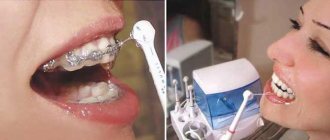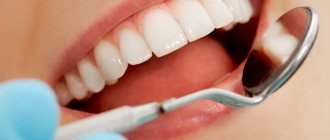Price for stone removal in dentistry
Tartar is removed in a dental clinic using modern techniques that allow the stone to be completely destroyed.
The earlier deposits are detected, the easier it is to remove them. The procedure takes about an hour in total. First, the doctor removes the supragingival stone, and, if necessary, the subgingival stone. Then the teeth are polished and a fluoride toothpaste is applied.
https://www.youtube.com/watch?v=cwcNNQfFbu8
In their work, dentists usually combine several methods of stone removal. This approach allows you to get the most effective results. Once the problem is eliminated, the risk of complications is significantly reduced.
Tartar is cleaned exclusively using special equipment that allows you to quickly destroy the structure of mineralized deposits. The choice of methods depends on your financial capabilities, as well as your health status. Naturally, the doctor has the right to recommend to you the method that will be most effective in your case.
The dentist recommends professional teeth cleaning regularly, approximately once every six months. By following the recommendations of doctors, you will always be confident in the health of your teeth. And in your beautiful smile too.
Today, dentists use several techniques - ultrasound, chemical, laser, mechanical and Air-Flow.
One of the easiest and most effective ways to brush your teeth. Under the influence of ultrasonic waves, even the largest, most durable and oldest deposits are destroyed. The main advantage of the method is the preservation of tooth enamel and the ability to treat subgingival pockets. Under the influence of ultra-high frequency waves, pathogenic bacteria also die, which contributes to the most complete disinfection of the oral cavity.
Cleaning is carried out using a special attachment - a scaler, which makes it possible to remove deposits even in the most difficult to reach places. During the manipulation, teeth are simultaneously polished, which also reduces the risk of rapid formation of new plaque.
Before the procedure, a gel is applied to the teeth, which, under the action of the device, releases free oxygen, which is involved in the process of destruction of the stone. Ultrasonic cleaning allows you to thoroughly clean not only the surface of the teeth and the interdental space, but also the periodontal canals, which is especially important for those who are prone to or suffer from periodontitis.
Despite the safety of the method, there are contraindications - the first trimester of pregnancy, the presence of implants and orthopedic structures, ARVI, arrhythmia, asthma, chronic bronchitis, tooth sensitivity. It is also undesirable to carry out the procedure on children and adolescents during the period of change in bite.
Important. When removing tartar with a scaler, the patient may feel pain, especially if the enamel is thinned. In such cases, the doctor applies a special anesthetic gel to the teeth.
The session lasts about an hour, after which the doctor polishes the teeth and applies fluoridated gel.
Chemical
It is carried out using special gels or pastes containing components that actively affect tartar and destroy its structure as a result of a chemical reaction. The acids and alkalis included in the preparations soften the stone, after which it is quite easy to remove.
The procedure is absolutely painless and, in some ways, even comfortable. The products have a pleasant taste and do not irritate the mucous membranes. Before the procedure, the doctor protects the patient’s gums and lips from exposure to chemicals. After removing the composition, the doctor polishes the surface of the teeth with an electric brush with a special paste.
The main advantage of the method is teeth cleaning while simultaneously whitening them. The enamel not only acquires its natural color, but becomes several shades lighter.
Among the disadvantages, it should be noted the possibility of damage (thinning) of the enamel and the inability to fully clean the teeth, since the compositions do not penetrate into hard-to-reach places. Chemical teeth cleaning is recommended only for removing hard tartar. If you treat soft plaque with compounds, it is very easy to damage the enamel (it becomes brittle and loose).
The method is considered one of the most inexpensive, but recently it has become less and less popular precisely because of the possibility of damage to the enamel.
Laser cleaning
Compared to the ultrasonic procedure, laser cleaning is considered more gentle, but no less effective. The destruction of the stone occurs due to the action of long waves, without direct contact of the device with the teeth. The method is painless, no anesthesia is required. Healthy tissues and enamel are not damaged.
We invite you to familiarize yourself with: Removing tartar, how to remove tartar (photos and videos)
The laser “removes” stone and any formations from the surface of the teeth layer by layer, while also having a wound-healing and bactericidal effect on the oral cavity. The use of laser stimulates tissue regeneration. In this case, we are talking about increasing the permeability of enamel for calcium and fluoride ions, which helps strengthen teeth.
The disadvantages of the method include the impossibility of laser cleaning of subgingival pockets and the high cost of the procedure.
Contraindications – pregnancy, the presence of endoprostheses in the body, viral and infectious diseases, braces.
Laser cleaning lightens the enamel. Bleaching is a separate procedure, which requires mandatory removal of stones.
Mechanical
Nowadays the method is used extremely rarely, but at one time it was the only way to remove stones. The doctor uses a special bur to pry up the stone, separate it from the tooth and then clean the surface.
Mechanical cleaning removes only surface deposits that can be removed with a boron. Patients in most cases experience discomfort and pain. The only advantage of the method is the low cost of the procedure.
Air-Flow
An effective way to remove hard and soft dental plaque. An abrasive mixture consisting of soda, water and flavoring is applied under pressure to the surface of the tooth, easily and quickly removing plaque and stones. Professional cleaning using the Air-Flow method (translated as air flow) does not injure the gums and does not damage the enamel.
During and after the procedure, patients do not experience pain or discomfort. Cleaning using the Air-Flow method allows you to quickly and carefully remove dental plaque, clean subgingival pockets and remove pathological granulations.
After the procedure, the teeth acquire a natural shade, but are not whitened.
The cost of the procedure depends on the chosen technique, as well as the condition of your teeth. In particularly advanced cases, repeated visits to the doctor may be required.
What is tartar and why is it dangerous?
Such deposits on teeth do not appear suddenly. First, plaque forms, which consists of saliva, dead epithelial cells, food particles and pathogenic microorganisms. At the 3rd stage of formation, aerobic bacteria are replaced by anaerobic ones, which leads to a significant increase in dental plaque. Within a few days, the plaque mineralizes (iron, phosphorus and calcium salts) and darkens, making it possible to distinguish it from enamel. This indicates the appearance of tartar.
It can reach its maximum size in 6-9 months. The speed of development of this process depends on the individual characteristics of the organism. The hardened mass usually forms in places where a toothbrush cannot always achieve a thorough cleaning procedure. Therefore, food debris accumulates there, which is an ideal environment for the proliferation of pathogenic bacteria (gaps between teeth, crevices and cervical area).
Types of dental stones.
| Species name | Characteristic |
| Supragingival | It has a yellow or brown tint and is clearly visible to the naked eye. It can be easily removed. Therefore, the answer to the question of whether it is painful to remove such stones from teeth will depend on the choice of technique. |
| Subgingival | Such a stone is located under the gum, so a person cannot see it on his own. Dentists identify deposits by probing periodontal pockets. In this case, the patient notices such signs as cyanosis and swelling of the gums. Often the doctor hears a complaint about their bleeding. If there are many formations, then suppuration is possible. |
Oksana Shiyka
Dentist-therapist
Important! Tartars form not only on teeth, but also on various orthodontic devices. Therefore, dental hygiene is very important at any age.
Such deposits on the teeth can pose some threat to human health, so the question of whether it is painful to remove tartar fades into the background. Many people perceive this problem as a small defect that disrupts the aesthetic appearance of the oral cavity. At the same time, people try to smile less and think that the cleaning procedure can be postponed, since nothing serious threatens their health.
Thanks to many years of research, doctors claim that such a dental problem can cause the development of serious diseases:
- caries;
- inflammatory gum diseases (periodontal disease, gingivitis, periodontitis, etc.).
These pathologies often lead to the appearance of an unpleasant odor in the mouth, during which a person experiences severe discomfort when communicating and eating. Elements of the dentition gradually begin to loosen, which often becomes the cause of their loss. In the absence of proper treatment, the bite is disrupted, and deviations in the functioning of various body systems occur. At the same time, a person should not worry about the question of whether it is painful to remove stones from teeth, because the longer he delays solving the problem, the more damage he causes to his health.
Is there any discomfort?
Unpleasant sensations depend on what specific stone we are talking about. It comes in two types: supragingival and subgingival. In the first case, tartar is located on the gingival part of the tooth, so it can be easily removed with hand tools. It appears due to the contact of saliva and the food that a person consumes.
Dental plaque can form above and below the gums
The pain during cleaning is mild and goes away quickly. After the procedure, the dentist will give detailed recommendations on how to brush your teeth and recommend special lotions and pastes that prevent plaque from appearing. You can find out more about them in the article “Toothpastes for Tartar”
Do your teeth hurt after brushing? Let's figure it out!
A snow-white smile and beautiful, straight teeth these days have become not just very popular, but also an extremely necessary feature of appearance, on which the quality of a person’s social communication, his professional career, and success in his personal life depend. Nowadays, many people use the services of specialists working in the field of aesthetic dentistry and regularly undergo professional dental cleaning. But not everyone is aware of the intricacies and features of such a procedure, so they wonder why their teeth hurt after brushing , for example, with the advertised safe ultrasound?
Learn more about the benefits of teeth whitening and teeth cleaning
Removal of dental plaque using Air flow and ultrasound
Tartar appears as yellow and brown spots, which often cause periodontal diseases. If they are not treated in time, you can lose your teeth. Therefore, regardless of whether it hurts to remove tartar, you need to regularly sign up for this procedure. There are several methods for removing deposits:
- mechanical;
- chemical;
- laser;
- ultrasonic;
- using Air flow.
The specialist prescribes one method or another only after examining the patients. The condition of the teeth, the type and structure of the stone, and the characteristics of the body are taken into account. Classic mechanical cleaning is often used. Ultrasound, laser and Air flow are innovative techniques that have appeared relatively recently.
The Air flow method is considered one of the most effective today. The procedure allows you to remove hard dental deposits from the enamel and return it to its natural whiteness. An abrasive mixture under high pressure comes out of the spout of the device used, cleaning the surface of the teeth and subgingival plaque. The abrasive is often soda, the use of which does not disturb the intestinal-alkaline balance. Herbal powders and decoctions are used. They clean teeth and strengthen gums.
The method is based on abrasive and air cleaning, eliminating surface deposits. Air flow is used when tartar is not very hard. Experts recommend the procedure if the deposits were previously removed using ultrasound and the surface of the teeth needs to be thoroughly polished. The procedure is absolutely painless, so you don’t have to worry about whether it’s painful to remove tartar using Air flow.
Air flow method - supply of abrasive substances under pressure
Tartar removal is effectively carried out using ultrasound. This is a new product in dentistry that gives excellent results. For cleaning, a special device is used - a scaler. Read more in the article “About ultrasonic tartar removal.”
If you liked the article, please like it.
We suggest you read: ᐉ How to treat gumboil - what to rinse with to remove swelling at home
Please share your experience of tartar removal in the comments.
Tags:Dental diseases, Tartar
The cleaning process: an inside look
As is clear from the name of the procedure itself (ultrasound), the physics of the process itself is determined by the presence of a high-frequency sound wave generator, inaudible to the human ear. The device that contains these components is called a scaler. On it you can change the frequency with which the generating element operates. The correct frequency is a very important parameter when performing cleaning. Only an experienced dentist can make the best choice.
A modern device, a medical facility and a specialist are the basis for a properly carried out cleaning procedure. In addition to treating visible formations on the teeth, the ultrasonic technique allows you to clean deposits located under the gums. “Does it hurt to remove tartar under the gums?” - the patient may ask. Yes, this procedure can cause discomfort. Therefore, it is performed only after preventive pain-relieving procedures.
Subsequent processing: fluoridation polishing
A mandatory step after brushing (except for Air-Flow) is teeth polishing. After the procedure, the enamel becomes slightly rough, as microscopic particles of stone and mechanical irregularities remain on it. If the surface of the teeth is not polished, plaque will settle much more intensely than before brushing.
For polishing, use special brushes or a water-air jet with an abrasive mixture.
To reduce tooth sensitivity after the procedure and strengthen the enamel, special compounds with a high content of sodium fluoride are applied to the surface of the teeth. The procedure is not mandatory, but its implementation will help to quickly restore damaged layers.
Features of professional teeth cleaning
Modern methods for removing tartar are a safe and comfortable procedure. It can be performed on absolutely every patient and even pregnant women.
The exception is a violation of the integrity of the enamel and increased sensitivity of the hard tissues of the teeth. Today, ultrasound is most often used for this.
The advanced technologies used help minimize pain and further negative consequences.
Carrying out the removal of tartar using ultrasonic units has several stages, which the doctor performs in a certain sequence:
- Pain relief . It is carried out as necessary. To achieve the desired effect, use application or, in extreme cases, infiltration anesthesia. The indication for pain relief is increased sensitivity of the soft and hard tissues of the patient’s oral cavity.
- Stone removal . This stage is the main one in professional teeth cleaning. Under the influence of ultrasound, tartar is destroyed and easily moves away from the enamel surface. The supplied stream of water helps remove even the smallest particles from the surface of the teeth.
- Using the Air Flow device . Quite often, this procedure is considered completely separately and has nothing to do with ultrasonic teeth cleaning. But with professional oral care, dentists use techniques to achieve the best results. The peculiarity of the procedure is that, under pressure, abrasive particles with a stream of water rush to the surface of the tooth from a special apparatus. They help remove remaining pigmentation, which can persist even from ultrasound. Thus, partial whitening of the enamel is ensured, and it becomes 1-2 shades brighter.
- Polishing of hard tooth tissues . In all cases, after the procedure, the enamel surface has a certain roughness. This condition will further ensure the rapid accumulation of plaque and the formation of new tartar. To prevent this from happening, the treated crown is polished using special rubber discs, brushes and other devices. The smooth surface will provide a natural shine to the enamel and protect the teeth from the negative factors of the oral cavity.
- Antiseptic treatment . It is mandatory, since the gums can be damaged during the procedure. In addition, usually due to dental plaque, periodontal tissues are partially inflamed, and the use of antiseptics will avoid additional complications and the spread of infection.
- Fluoridation of teeth . This stage of treatment is necessary for certain indications. For example, if the enamel is prone to destruction, is weak, or has increased sensitivity, then the use of fluoride-containing preparations will strengthen it.
- Use of medicinal dressings . They are necessary for severe periodontal inflammation, bleeding or significant trauma that occurred during the removal of dental plaque. The dressings are prepared immediately before use. Depending on the indications, they contain antibiotics, sulfonamides, antiviral drugs, fungistatic agents, as well as antiseptics and enzymes.
You can learn how dental plaque is removed using ultrasound by watching the video in this article.
Mechanical cleaning
This method of cleaning tartar is a classic one. This procedure requires tools that remove hardening in hard-to-reach areas. As a result, gum pockets and spaces between teeth are cleaned. Using mechanical cleaning, you can achieve complete cleanliness of the enamel. But you should only trust your teeth to an experienced specialist, since the edges of the instruments are very sharp and can damage the enamel and oral cavity. It is recommended to remove stones from teeth mechanically once every 6 months.
Set of tools for mechanical cleaning
Metal devices (hooks) and special brushes with abrasives are used. Today there are brushes for home use that operate on sound energy. Thanks to the electromagnetic device, the vibration frequency can be controlled. You need to use them yourself with extreme caution so as not to damage the gums.
Chemicals are very rarely used in modern clinics. They are relevant when it is not possible to remove solid deposits using other methods. Dentists use alkalis and acids that soften tartar. After this, it can be easily removed mechanically.
The chemical method is very risky, since using it can injure tooth enamel and burn the oral mucosa. But the procedure is relatively inexpensive, requires a minimum of time and does not cause discomfort. If the sensitivity of the enamel is high, you cannot use chemicals. Acids will damage the enamel.
Only an experienced dentist should use acid or alkali.
The process of removing tartar is simple for a dentist, but carrying out such a procedure at home using improvised means is not recommended. If you suspect the formation of deposits, you should seek help from a specialist.
Laser cleaning
The laser teeth cleaning technique is one of the most effective and safe. The principle of operation of the method is based on the effect of rays, which manifests itself upon contact with water. The advantage of the method is that the laser does not harm the enamel. This effect is explained by the fact that tartar contains more water than tooth enamel.
Before starting the procedure, the doctor must make sure that the patient does not have any contraindications. The list of conditions in which dental procedures are prohibited can be presented as follows:
- immunodeficiency states,
- HIV status,
- age up to 18 years,
- wearing braces,
- hepatitis,
- period of pregnancy and lactation,
- ARVI period,
- heart disease,
- bronchial asthma.
The advantage of this method is its noiselessness. Even patients who are afraid of the drill can easily visit the dentist. The effect of the laser lasts for several years, depending on what kind of oral care the patient provides. The laser kills pathogenic microorganisms, improving the general condition of the oral cavity.
Dry cleaning
The chemical cleaning procedure is not a viable method. To achieve the desired result, other methods must be used in combination with it.
The use of chemical reagents is resorted to in the following cases:
- the deposit is quite strongly adhered to the tooth,
- the formation cannot be removed using other methods,
- There are contraindications to the use of alternative methods.
Acid and alkaline solutions can be used to dissolve deposits. They are applied to the enamel using cotton wool.
The list of contraindications to the use of the method can be presented as follows:
- epilepsy and other systemic diseases,
- pregnancy period,
- breastfeeding period,
- inflammation of the gums,
- allergic reactions in the patient to the active substance of the medicinal composition.
We suggest you read: How to glue dentures at home - How to glue cracked dentures
Mechanical cleaning
The mechanical cleaning method is considered outdated and is practically not used in modern practice. Private dental offices have abandoned its use in favor of ultrasound precisely because of the pain and duration. Dentists say that mechanical cleansing can cause damage to the enamel. Injuries may occur during the removal of deposits.
Removing tartar mechanically is quite painful. The disadvantage of the method is also the high risk of complications after the intervention.
The mechanical process of removing fossilized particles from teeth is a little outdated, but many dentists use it, considering it tried and true.
Advantages of the method:
- prevalence,
- availability,
- reliability.
Disadvantages of this method:
- risk of various injuries in the oral cavity,
- damage to tooth enamel,
- discomfort during manipulation,
- increased enamel sensitivity after the procedure.
What are the recommendations for using ultrasonic teeth cleaning?
It's no secret that cleaning tartar at home is also possible. There are even special brushes sold for these purposes. But this may not always bring positive results. In such cases, you should resort to ultrasound procedures under the guidance of a specialist, which will give the result: removal of tartar. Potential clients for this procedure are those who have no known medical conditions.
Precise, targeted ultrasound exposure is almost irreplaceable for those whose teeth are located very close to each other or access is difficult due to the presence of orthopedic dentures. In addition, work on installing dentures must be preceded by cleaning of all excess on the surface of tooth enamel and gums: plaque, stone, and microbial residues. The ultrasonic method not only removes surface deposits, but also cleans hard-to-reach cavities, such as between teeth or pockets between the gum and the base of the tooth.
Removal at home
It is impossible to remove hardened tartar at home. The only thing you can do is try to remove soft dental plaque. To do this, use special rotating toothbrushes and abrasive toothpastes. You can use such compositions no more than twice a week so as not to damage the enamel.
The use of folk remedies gives a dubious effect, but, if desired, you can try and see for yourself.
- Radish and lemon juice. Grate the radish, add natural lemon juice. Wet the brush and rub your teeth. (The main component of this “elixir” is acids that destroy enamel).
- Eggplant ash. The vegetable should be burned over an open fire, and the most problematic areas should be rubbed with ashes every day. The expected result can be observed after a week and a half.
- Horsetail decoction (for 200 grams of water - 30 grams of dry herb). Boil for half an hour. Rinse your mouth morning and evening with 1/3 cup.
Important. Among the “folk” recipes found online, there is an infusion of celandine, the use of which poses a health hazard.
Causes of gum pain after stone removal
Unpleasant sensations almost always occur after certain dental procedures. All the reasons why periodontal pain appears are associated with two groups of factors.
The first is individual increased sensitivity of hard and soft tissues of the oral cavity. The second is associated with various gum diseases, such as gingivitis, periodontitis, periodontal disease, histiocytosis and other pathologies.
Tartar itself can cause these problems. It is because of this that most diseases develop in the periodontium.
Medical intervention provokes some exacerbation of the pathology, and the symptoms thereby intensify. But if you follow all the dentist’s recommendations, the discomfort will subside within a few days.
The instructions received from the doctor for the rehabilitation period must be followed without fail. This will ensure a speedy recovery and help prevent complications.
In addition, the following may be the reasons for discomfort after professional teeth cleaning:
- enamel microcracks;
- incorrectly selected toothpaste;
- cariogenic damage;
- inflammatory process in the gums;
- damage to the mucous membrane;
- soft tissue injuries;
- pulpitis or periodontitis of the tooth;
- The toothbrush is too hard.
Laser stone removal
Many clinics have installed modern laser equipment that allows you to effectively and quickly remove hard plaque. The method is painless and effective. Innovative laser systems crush fossilized deposits and remove plaque.
The device does not harm the inside of the teeth and enamel, because it only affects substances containing water. There is no water in the enamel and tissues, so they are safe. The laser quickly removes plaque and subgingival stone. The procedure causes mild discomfort to patients, but it soon goes away. To make the effect last longer, it is recommended to combine laser cleaning with Air flow. If the patient has periodontitis, after cleaning it is necessary to undergo anti-inflammatory therapy.
Laser removal of dental plaque
Gums hurt after stone removal: causes and methods of eliminating the problem
Even the most thorough oral care does not provide 100% protection against some dental problems. This is largely due to the peculiarities of the anatomical structure and the correct implementation of all hygiene procedures.
To avoid possible diseases, it is necessary to visit the clinic at least once every 6 months for professional teeth cleaning. However, many ignore this manipulation, claiming that their gums hurt quite seriously after removing stones and other preventive procedures.
Is it painful to remove tartar?
The procedure is absolutely fearless. Persons suffering from individual sensitivity are recommended to administer a local anesthetic.
The least painful methods are laser and ultrasonic cleaning. The patient may experience discomfort if choosing a mechanical method. After the manipulation, mild discomfort may persist in the oral cavity, which disappears within 24 hours.
The specialist explains to the patient the rules of dental and oral care. Simple manipulations will help avoid complications, and proper oral care will prevent the formation of new stones. Proper care involves using quality care products. For daily brushing, you need to use not only toothpaste, but also mouthwash and dental floss.
The answer to this question is not clear-cut.
Mechanical cleaning causes some discomfort and minor pain in patients.
Laser, chemical and Air-Flow cleaning are absolutely painless; anesthesia is not required.
Ultrasonic treatment of teeth with a scaler in most cases requires the application of a local anesthetic, especially in cases of increased tooth sensitivity.
Modern dentistry has an extensive list of painkillers. If, because of your imaginary fear, you allow the formation of old formations on your teeth, you will subsequently have to undergo long and expensive treatment.
What is dental plaque?
This formation, which appears on the surface of tooth enamel, creates favorable conditions for the development of various diseases, the most famous of which is caries.
If such plaque forms near the gum, it becomes swollen. This gum gradually moves away from the body of the tooth, and a cavity is formed in which bacteria accumulate. A place that is difficult to clean becomes a source of various inflammations. For hygiene reasons, such a stone should be removed. A timely procedure for removing tartar will preserve the conditions in the oral cavity necessary for the existence of healthy teeth. The existing methodology in dentistry allows for the removal of such stones in several ways.
Prevention
The main requirement for preventing the appearance of tartar is regular and proper oral hygiene, including daily brushing of teeth (at least twice - morning and evening), rinsing after meals, using dental floss and irrigators.
The second, no less important condition is proper nutrition, including solid raw vegetables and fruits. The acids they contain soften plaque, and fiber helps remove it. Green apples are especially effective in this regard.
Try to limit the consumption of strong black tea and coffee, and, if possible, nicotine.
Important advice. If you notice something wrong with your teeth, contact a specialist immediately. It will be more reliable this way.
Rules of conduct for the period of rehabilitation
After the doctor carries out professional teeth cleaning, you need to follow certain recommendations for about a week. Correct behavior will allow you to maintain the positive result obtained for a long time and prevent the development of additional pathologies.
The main recommendations after performing the manipulation are:
- Two or three times a day, especially after meals, be sure to rinse your mouth with a disinfectant solution. The best results are obtained with a drug such as Chlorhexidine. However, one side effect has been noticed. With long-term use, after using Chlorhexidine, a gray coating remains on the surface of the enamel and mucous membrane. In this case, you can use its analogue, Miramistin solution. These drugs cannot be used for more than 5 days, as they can suppress the entire microflora, which leads to local dysbiosis.
- If bleeding occurs, it is recommended to use applications of special ointments and gels. Metrogyl Denta gel is excellent for these purposes. It must be applied immediately after meals 2-3 times a day, using a cotton swab for 20 minutes. The therapeutic course should be 3-5 days. If after some time there is no result, then Metrogyl-Dent must be replaced with another drug.
- To accelerate the regeneration of periodontal tissue, use Solcoseryl paste or Paradontax. These drugs will help not only epithelize damaged periodontal tissue, but also strengthen the gums for a long time.
- To maintain the results obtained, it is necessary to use additional oral care products, such as dental floss, rinses, the use of an irrigator and the selection of highly effective toothpastes.
Preventing tooth sensitivity and gum inflammation after brushing
In order to avoid pain after professional teeth cleaning, you should take preventive measures and maintain oral hygiene:
- before removing tartar, cure caries and gum disease (we recommend reading: how to remove tartar located under the gum?);
- visit your dentist regularly for preventative purposes - eliminating microcracks in enamel is easier than treating caries;
- have it professionally cleaned every three to four months;
- Change your toothbrush to a new one every three months.
You can avoid problems after removing tartar (see also: photos of teeth before removing tartar and after the procedure). To do this, you need to take care of your oral cavity, visit the dentist regularly and take good care of your teeth. Dental diseases affect the condition of the entire body, so healthy teeth are not just beautiful, they are, first and foremost, an indicator of your health.
Main types of hyperesthesia
Dental hyperesthesia is divided into several types:
| By distribution and extent of damage: |
|
| Due to the occurrence: |
|
| According to clinical manifestations: |
|
An important feature of hyperesthesia is that with increased sensitivity, treatment is difficult. All actions of the dentist can cause pain and discomfort to the patient. The pain can be localized in the area of one tooth, or the susceptibility to a number of irritants may increase.
Let's look at the main causes of tooth sensitivity and ways to eliminate them, and also learn how to treat hyperesthesia of hard dental tissues.
To everyone and everyone
Professional preventive cleaning of the oral cavity is recommended 2 times a year. Teeth cleaning - Moscow, as a vanguard in the provision of dental services, actively uses lasers in hygiene and treatment. The procedure is beneficial for everyone, including those with healthy teeth and strong gums. Brushing your teeth before treatment allows the dentist to do a better job. You can identify caries at an early stage of its development and select a filling of the desired shade.
Indications for laser cleaning include the formation of plaque on teeth, bad breath, and the initial stages of gum inflammation. Increased acidity, long-term smoking or addiction to coffee and tea - laser teeth cleaning is indicated here. Laser cleaning should be carried out before the upcoming treatment of teeth and gums, before teeth whitening.
There are also contraindications to laser plaque removal. Most of them are temporary, and permanent ones are determined by the patient’s health condition:
- age less than 18 years;
- pregnancy and lactation;
- braces systems in the oral cavity;
- a large number of fillings, extended teeth;
- periodontitis;
- diseases of the heart and blood vessels;
- chronic bronchitis, bronchial asthma;
- acute infections;
- tuberculosis, hepatitis, HIV, herpes;
- the presence of endoprostheses in the body;
- high sensitivity of teeth.
Why do teeth hurt when brushing incorrectly?
Some patients complain of acute and unbearable pain when brushing their teeth, which practically does not bother them at other times. It occurs when toothpaste is applied to the enamel or the fibers touch the surface of a molar. In this situation, dentists suggest one of the problems:
- wedge-shaped defect;
- hypersensitivity to irritants due to thinning of the enamel in some areas.
The first disease often occurs in people with congenital malocclusion. Sometimes the pathology develops after a fracture of the jaw bones and other acquired defects. With them, the teeth are located at a slight slope and gradually wear out in the area of contact with the gum. In these places, white and dark spots form faster and the crown may rot.
Increased sensitivity is a common enamel pathology. It occurs for a number of reasons and causes a lot of inconvenience to a person. The first symptom is that your teeth hurt while brushing. Then discomfort begins to occur when eating cold or hot food, or when going outside in windy or frosty weather.
Pain when brushing your teeth can result from:
- poor oral hygiene;
- poor quality nutrition;
- vitamin deficiency;
- first stage of caries.
Even a brush that is too hard can cause this complication. Dense bristles scratch the base of the dental crown, leaving microdamages and grooves. They expose dentin, which protects the pulp and reacts sharply to contact with acids and sweets.
We brush our teeth correctly
To prevent your teeth from hurting and your gums from bleeding after brushing, it is important to find suitable accessories and follow the key rules of oral hygiene:
- Pay attention to the size and hardness of your toothbrush. It is important that during cleaning the gums are not injured and the integrity of the enamel is not damaged. Choosing the right size is easy - buy a model that does not cause a gag reflex, that is, it treats the teeth and gums, but does not grab the root of the tongue.
- Brush your teeth for at least three minutes . Quick movements of the brush “from top to bottom, as we were taught in kindergarten” for 30 seconds will not protect teeth and gums from bacteria. For the paste to work effectively, it is important to thoroughly clean all surfaces of the crowns - anterior, posterior, chewing and proximal surfaces.
- Remember your cleaning technique . Massage your teeth and gums well with the brush, gently pressing in a circular motion on the tissue. It is important not only to clean your teeth, but also to massage your gums from the outside and inside. Such manipulations will increase blood flow and strengthen tissues.
- Remember to use dental floss to remove food debris between your teeth.
- Pay attention to the rinse aid. After brushing your teeth, dentists advise rinsing your mouth with a specially selected composition or herbal decoction. Good remedies are oak bark, chamomile and sage.
